During this pandemic, I’ve basically been living off of eBooks. Unfortunately, that means I haven’t really kept up with picture books. I personally don’t really like reading picture books or graphic novels in digital format, but it’s gotten to the point that I’m really missing out on a lot because of that, so I’ve finally read a bunch of picture books for the sake of writing these brief reviews. In some cases, these are already-published books that I acquired the normal way, (that is, with a library card) while others were ARCs (Advanced Reader Copies) which I got from NetGalley. On this list, I’ve included all of the picture books that I got from NetGalley but only my favorites among the books I checked out. For all of the books that aren’t out yet, I’ve added a note specifying the expected publication date according to NetGalley.
Swim, Mo, Swim! By David A. Adler, illustrated by Sam Ricks
This early reader is the latest in a series of sports-themed books about Mo Jackson, a boy who is more talented than he realizes and tends to win athletic events unexpectedly. They’re written at about a first grade reading level, with multiple sentences per page and a fair amount of multi-syllable words. They’re great books for a student who is comfortable reading full sentences but not yet ready for chapter books, especially if that particular child prefers realistic fiction about real kids over cutesy anthropomorphic animals. While I personally don’t find these books especially humorous, and they always seem to end awkwardly abruptly, I understand the appeal and think they’re worth their spots on library bookshelves.
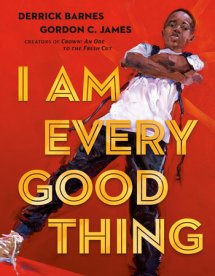 I Am Every Good Thing by David Barnes, illustrated by Gordon C. James
I Am Every Good Thing by David Barnes, illustrated by Gordon C. James
Gorgeous oil-painted illustrations accompany this poetic, feel-good list of positive affirmations. An African American boy who looks to be about seven or eight years old describes himself as various things he loves, like Saturday mornings in the summer and a grand slam. Some of his self-descriptions are very specific, reflecting his own interests in science and sports, while others are more general, describing his energetic and curious personality. He also describes himself as a brother, son, nephew, cousin, grandson, and friend. (That page is probably my favorite part; I love the picture of him hugging a girl who is presumably his sister) The book ends with the boy simply saying that he is worthy to be loved. Despite the fact that this story doesn’t consist of a chronological narrative, and the main character isn’t even given a name, by the end of the book, readers will feel like they really know this kid and like him. For me, the best part of this book is the artwork, but the positive messages and the lovable protagonist are big selling points, too.
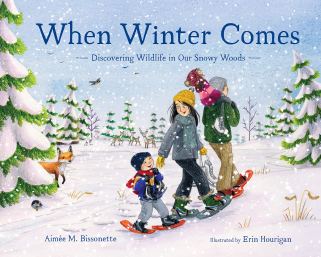 When Winter Comes: Discovering Wildlife in Our Snowy Woods by Aimee M. Bissonette, illustrated by Erin Hourigan
When Winter Comes: Discovering Wildlife in Our Snowy Woods by Aimee M. Bissonette, illustrated by Erin Hourigan
This title has not yet been released. Expected publication date is October 13.
A family happily engages in outdoor winter activities like skating, snowball fights, ice fishing, and skiing in this cheerful, seasonal picture book. As they do so, they are consciously aware of the animals around them. Some, like the tree frogs, are hibernating, while others, like the field mice, tunnel beneath the ground and come out occasionally for food. Meanwhile, the fish are still active beneath the ice and the birds seek shelter in the trees. The illustrations appear to be mixed media including some kind of pencil or ink for the fine lines and something like charcoal for the texture of the snow, sky, water, and dirt. After reading it once through, I went back and took a closer look at the art style, and I love the realistic color palette used for the snow. The overall effect is pure, clean, quiet white, but there’s actually quite a bit of blue and pink and gray for showing the drifts and shadows and sunlight. The bright blue sky and the green branches of the pine trees make for a very colorful look overall. I think kids will especially like the pictures in which you can see the animals hidden from the human characters below the surface of the ground or the ice. This book will make a great read-aloud, either as part of a storytime or at home. I think it would pair well with Kevin Henke’s When Winter Is Here from 2018.
Bear Against Time by Jean-Luc Fromental, illustrated by Joelle Jolivet
(Originally published in French in 2018, English language version has a scheduled publication date of February 16, 2021)
Bear always shows up for everything at the wrong time. He’s late for school, he misses lunch and goes to the wrong classrooms, and he doesn’t come home on time. The problem is that he doesn’t know how to tell time. The father in the human family he lives with (for some unexplained reason) teaches him how to read a clock, and Bear’s life suddenly changes. Now he’s always on time and he has plenty of free time, which he fills up with so many extra-curricular activities that he collapses from burnout. It’s a little unclear what the point of this book is. Is it to teach children how to read a clock? Is it to make a point about the importance of being on time? Or is it a warning against the harmful effects of an overly busy schedule? While these are all valid points, they don’t mesh into a cohesive story. I don’t especially recommend this book.
Find a Moose With Me! A Countdown Adventure by Suzanne Buzby Hersey
This title has not yet been released. Expected publication date is November 24.
It’s Oscar’s first moose hunt! He and his parents are going on a hike in search of a moose they can photograph. As they walk, they count things they see, starting with ten pinecones, nine turtles, and eight beavers, and eventually counting down to two loons and finally, one moose. The rhyming text generally does a good job of sticking to the meter. The artwork is appealing but somewhat inconsistent in style. For some reason, Oscar’s facial features are overly simplified and slightly out of proportion while the animals are drawn in beautifully precise detail. Perhaps this was deliberate for the sake of making a point about environmentalism and de-emphasizing the humans, but if so, I don’t feel like that was especially well done. While this book doesn’t stand out as being exceptionally good, it is an enjoyable read and probably worth recommending to someone who’s specifically looking for picture books about nature for a child around three years old.
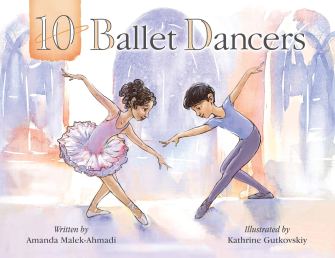 10 Ballet Dancers by Amanda Malek-Ahmadi, illustrated by Kathrine Gutkovskiy
10 Ballet Dancers by Amanda Malek-Ahmadi, illustrated by Kathrine Gutkovskiy
This title has not yet been released. Expected publication date is October 13.
I always love finding a new ballet picture book that actually uses terminology correctly and depicts the dancers’ anatomy more or less accurately. This book already appeals to me for that reason, especially because the female dancers’ pointe shoe ribbons are tied properly! I also really like the artistic style. The dancers are drawn with precise lines evidently drawn in ink, while the background is more abstract without clearly defined lines. I’m guessing it’s watercolor. It’s clearly a spacious, brightly lit studio with huge windows and a very shiny floor, but the focus is on the dancers. This would be a great book for kids who take ballet and will recognize the terminology, but it would also be a great book for a ballet-themed storytime intended to introduce kids to dance. My only complaint is that the ABB rhyme scheme feels a bit weird.
Night Animals Need Sleep, Too by Gianna Marino
This book is a sequel to Marino’s 2015 book simply titled Night Animals, but it works as a standalone story, too. Since Possum and Skunk are night animals, they need to find someplace dark and quiet to sleep during the day. First they find a promising cave, but it turns out to have bees. Bear follows them as they continue their quest and try to get some sleep in a hollow tree. But then Beaver chops it down. Next, they find a hole that turns out to be a fox den and a tent that belongs to humans. By then, it’s nighttime and it’s time for night animals to wake up anyway. While this story may lack a satisfying conclusion, it has a cumulative pattern, humorous characters, and an appealing simplicity that will make it a great read-aloud for preschoolers. Adults will probably want to inform kids that possums like to play dead in order to avoid confusion and maximize humor.
Jade Braves the Dark by Valdene Mark, illustrated by Sawyer Cloud
I’ve seen this title around enough that I guess I had high hopes for it which it didn’t quite meet. My biggest complaint is that the meter of the rhyming text wasn’t entirely consistent, which detracts from its value as a good read-aloud book. While toddlers and preschoolers don’t generally understand the concept of a regular meter, it still constitutes a strong appeal factor and builds early literacy skills. So it’s worth doing well, and this particular book falls short; it has a few too many lines with an extra syllable or two. The style of the artwork was somewhat appealing but not especially distinctive or impressive. I’ve seen a couple people compare the illustrative style to Pixar, which I think is a fair comparison.The simple storyline about a girl suddenly overcoming her fear of the dark is apparently intended to help children deal with their own fears, but Jade’s sudden epiphany is too unrealistic to provide much comfort.
Hike by Pete Oswald
In this wordless picture book, a father and child wake up early to drive away from their city home and take a mountain hike. Together, they enjoy the beauty of the scenery and the challenges of the path, including a scary log bridge and steep rocks to climb. They plant a tree and take a picture before returning to their vehicle and driving away. By the time they get back to the city, it’s night. Father and child share a bedtime snack of milk and cookies and look at a family photo album. Presumably, they add the picture from today’s hike to the album. This is not a story with fully-fleshed-out exposition, conflicts, climax, and resolution, but it is a heart-warming picture of a positive parent-child relationship and enriching experience. The digital illustrations are simple and not entirely realistic, yet they do a beautiful job of depicting the sights and experiences of a day out in nature.
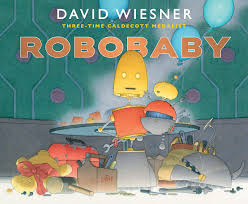 Robobaby by David Wiesner
Robobaby by David Wiesner
Cathode is getting a new baby brother. But first, his parents Diode and Lugnut must assemble the baby and install the operating system. You see, Cathode and his family are robots. While the robot aspect is already a significant appeal factor, this book will especially resonate with young humans who have recently become older siblings. The adult robots’ excitement over the baby and their panic when things go wrong will feel very familiar to readers with new babies in their own families. But unlike in many books with a similar plot, our protagonist doesn’t mind the attention being lavished on the baby. She just wants the adults to let her participate and help out a little more. Most of the plot is told with the pictures; the text is limited to the word bubbles, plus the packaging, instruction manuals, and computer installation screen within the pictures. The bright, cartoonish illustrations will be very visually appealing to kids in the preschool age range. I noticed that this book did not have great reviews on Goodreads, but it appears that most people’s primary complaint was that the picture-based plot and comic-like format isn’t especially conducive to reading aloud to a group. That’s okay; not every picture book has to be a good group storytime book.
A Real Friend by Jennifer Wolfthal, illustrated by Judi Abbot
This title has not yet been released. Expected publication date is November 10.
Benny and Max are best friends, but lately, Max has really been bugging Benny. After an argument one day, Max and Benny decide that they aren’t friends anymore. Benny gathers odds and ends and builds a new best friend for himself. His name is Jax, and he always does whatever Benny wants. But after a while, Benny gets bored and misses the things he used to do with Max. He goes to Max’s house and introduces Max to Jax. It turns out that Max also built a new friend for himself named Lenny. The two real boys are best friends again, and they spend the rest of the day playing together with their robots. This is a feel-good story that would work well in a storytime with a robot theme or a generic friendship theme.
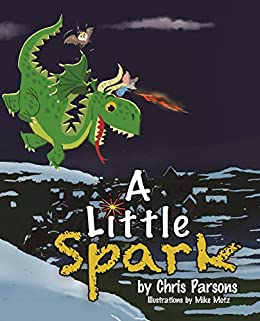 A Little Spark by Christ Parsons, illustrations by Mike Motz, 2020
A Little Spark by Christ Parsons, illustrations by Mike Motz, 2020 I Am Every Good Thing by David Barnes, illustrated by Gordon C. James
I Am Every Good Thing by David Barnes, illustrated by Gordon C. James When Winter Comes: Discovering Wildlife in Our Snowy Woods by Aimee M. Bissonette, illustrated by Erin Hourigan
When Winter Comes: Discovering Wildlife in Our Snowy Woods by Aimee M. Bissonette, illustrated by Erin Hourigan 10 Ballet Dancers by Amanda Malek-Ahmadi, illustrated by Kathrine Gutkovskiy
10 Ballet Dancers by Amanda Malek-Ahmadi, illustrated by Kathrine Gutkovskiy Robobaby by David Wiesner
Robobaby by David Wiesner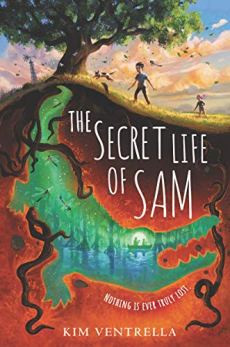 The Secret Life of Sam by Kim Ventrella, 2020
The Secret Life of Sam by Kim Ventrella, 2020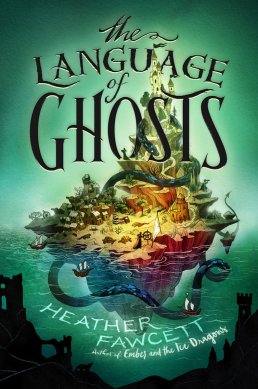 The Language of Ghosts by Heather Fawcett, 2020
The Language of Ghosts by Heather Fawcett, 2020